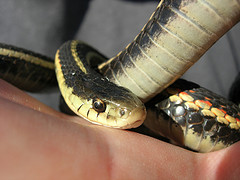It is extremely difficult to determine a species of snake from their faeces. Other than knowing whether it is a large or small snake, not much else can be detected from snakes' droppings or 'scat'. As a snake that does not live in a particular habitat, their faeces can be found in a variety of locations. Typically, they like to stay near water, so look near any lakes, ponds or stagnant water for evidence of droppings. The Garter snake is a reasonably small subspecies so any faeces that may be found will also be small in size.
Garter snakes are found quite commonly across North America. The San Francisco garter snake, however, is an endangered subspecies that has been on the endangered list since 1969. Like all other snakes, a garter snake is carnivorous and lives off slugs, leeches, earthworms, lizards, birds, toads, fish and rodents. Garter snakes that reside by water will eat other aquatic animals and will sometimes eat eggs. The subspecies is one that will adapt to eat anything that it can find, particular if food is scarce. The snakes are slightly venomous but cannot kill humans.
Their posterior teeth make it nearly impossible for them to deliver the poison and any amounts that they do produce are minute. The garter snake has a complex system of pheromonal communication and can find other snakes by following their scent. The pheromones given off by males and females are very distinctive although some males can produce both.
These snakes are called 'she-males' and have been shown to garner more copulations than normal males. Garter snakes are heterothermic, which means that they will bask in the sunshine in order to raise their body temperature. When they hibernate, the subspecies group together in large, communal sites and can travel long distances in order to find the right spot.
Garter snakes are found quite commonly across North America. The San Francisco garter snake, however, is an endangered subspecies that has been on the endangered list since 1969. Like all other snakes, a garter snake is carnivorous and lives off slugs, leeches, earthworms, lizards, birds, toads, fish and rodents. Garter snakes that reside by water will eat other aquatic animals and will sometimes eat eggs. The subspecies is one that will adapt to eat anything that it can find, particular if food is scarce. The snakes are slightly venomous but cannot kill humans.
Their posterior teeth make it nearly impossible for them to deliver the poison and any amounts that they do produce are minute. The garter snake has a complex system of pheromonal communication and can find other snakes by following their scent. The pheromones given off by males and females are very distinctive although some males can produce both.
These snakes are called 'she-males' and have been shown to garner more copulations than normal males. Garter snakes are heterothermic, which means that they will bask in the sunshine in order to raise their body temperature. When they hibernate, the subspecies group together in large, communal sites and can travel long distances in order to find the right spot.

